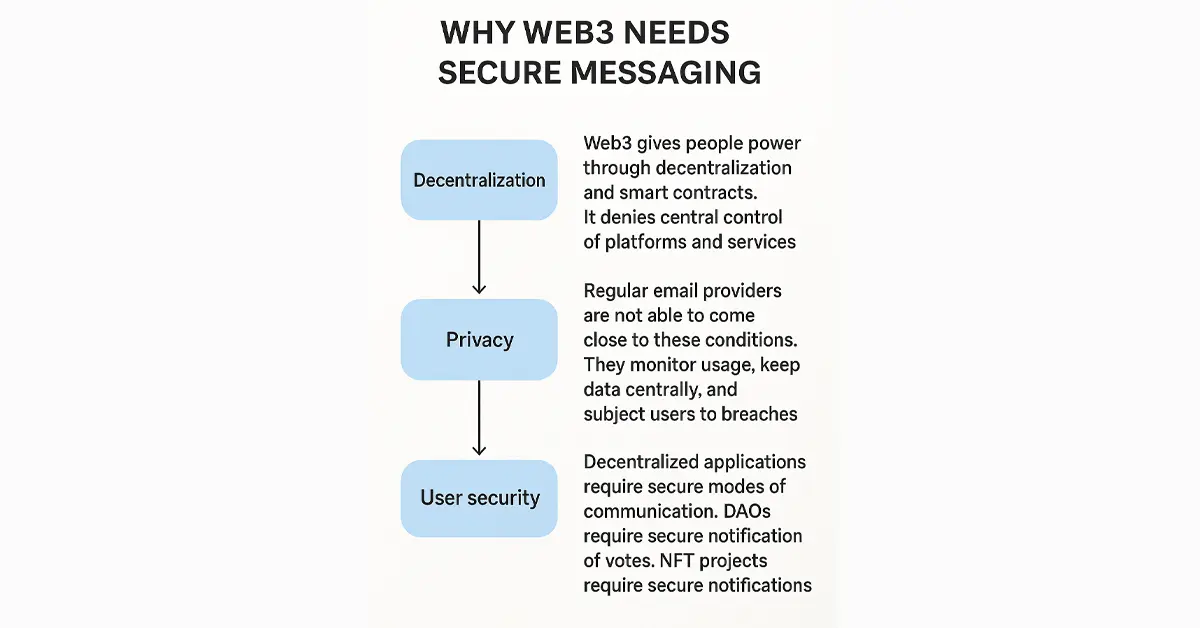
What if your email were secure, private, and blockchain-based? That is where Dmail Web3 comes in. The innovation revolutionizes digital communication using blockchain paradigms. As data privacy concerns increase, users require reliable systems.
Dmail web3 consolidates decentralization, encryption, and user control into a strong platform. As Web3 continues to grow, safe messaging is of the highest significance.
This article delves into the role Dmail Web3 plays in communication. It also summarizes its main features, applications, and future potential.
This article discusses how Dmail Web3 offers internet communication through blockchain. It segments out features, use cases, and architecture.
You’ll learn why Web3 needs encrypted, user-controlled messaging. Understand how DMail Web3 empowers privacy, identity, and trustless interactions.
Understanding Dmail Web3 Communication
Dmail web3 uses blockchain to enable secure and user-controlled communication. It removes the centralized servers from the picture. Messages get delivered through smart contracts instead of traditional mail servers.
Users completely own their data and identity. There is no room for unauthorized access or surveillance. End-to-end encryption is applied to all messages. Hackers cannot intercept or alter communications.
The identities are secure through the open-source cryptographic wallets. Spam is also reduced. Senders need to satisfy requirements or pay tokens before sending messages. The system suppresses unwanted or low-value communication.
It facilitates meaningful, actionable conversations. The protocol applies to most blockchains. It provides privacy-focused digital transactions in a decentralized setting. Businesses and users enjoy secure, authenticated message exchange in real time.
Ncog is the basis for secure, decentralized communication protocols. It enhances message reliability, privacy, and identity on networks.
Key Features of Dmail Web3
The following are the key features that contribute to Dmail Web3 being a robust decentralized communication system. They all enable secure, safe, and blockchain-based messaging.
On-Chain Identity Integration
The user’s identity is identified with a crypto wallet. It serves as a replacement for a common email address and password.
Wallets establish possession through cryptographic signatures. The user can only read messages if they are authenticated. The mechanism renders identity theft and impersonation impossible.
Smart Contract Automation
The platform is serverless. All messaging transactions are executed by smart contracts.
All actions are executed on predefined blockchain logic. This provides transparency and prevents tampering. Users trust in code, not third-party servers.
End-to-End Encryption
Messages are encrypted from sender to recipient. No third-party view or intercept content. Only permitted recipients can decrypt and use messages.
Encryption secures the conversation at every point. This keeps surveillance or leaks away.
Spam Filtering by Design
Senders need to qualify to reach inboxes. Token-based blocking restricts access to receivers.
It prevents bulk spamming and unwanted mail. Users remain the masters of their inbox. All messages are important and have a purpose.
Cross-Chain Compatibility
The system is designed to be compatible with cross-chain environments in many blockchains. Customers can interact across Ethereum, BNB Chain, and more.
Cross-chain compatibility extends reach and accessibility. It links users across multiple networks. This enhances mass adoption and flexibility.
Permanent Recordkeeping
Users can store messages on-chain forever. The records cannot be deleted or changed. Legal and confidential uses are ideally suited for permanent storage.
It brings accountability and traceability into messaging. Users have control over what and when to archive.
Why Web3 Needs Secure Messaging

Web3 gives people power through decentralization and smart contracts. It denies central control of platforms and services. Communication also has to take this same route.
Regular email providers are not able to come close to these conditions. They monitor usage, keep data centrally, and subject users to breaches.
Dmail web3 promotes the Web3 ideals of privacy, self-control, and ownership of data. There is elimination of third-party access, and encryption is enforced.
Messages are delivered via smart contracts and not corporate servers. This enhances user security and trust.
Decentralized applications require secure modes of communication. DAOs require secure notification of votes. NFT projects require secure notifications.
Tamper-proof messaging is employed by users of crypto. Secure messaging keeps users in the know without sacrificing control or transparency in Web3 spaces.
Decentralized Email System: A Paradigm Shift
A decentralized email system revolutionizes electronic communication. It eliminates corporate control of users’ messages. No platforms surveil and store anymore.
Blockchain instead provides incorruptibility as well as transparency. Users have control over access to their content. They manage their identity with cryptographic wallets Dmail web3…
Comments
Post a Comment